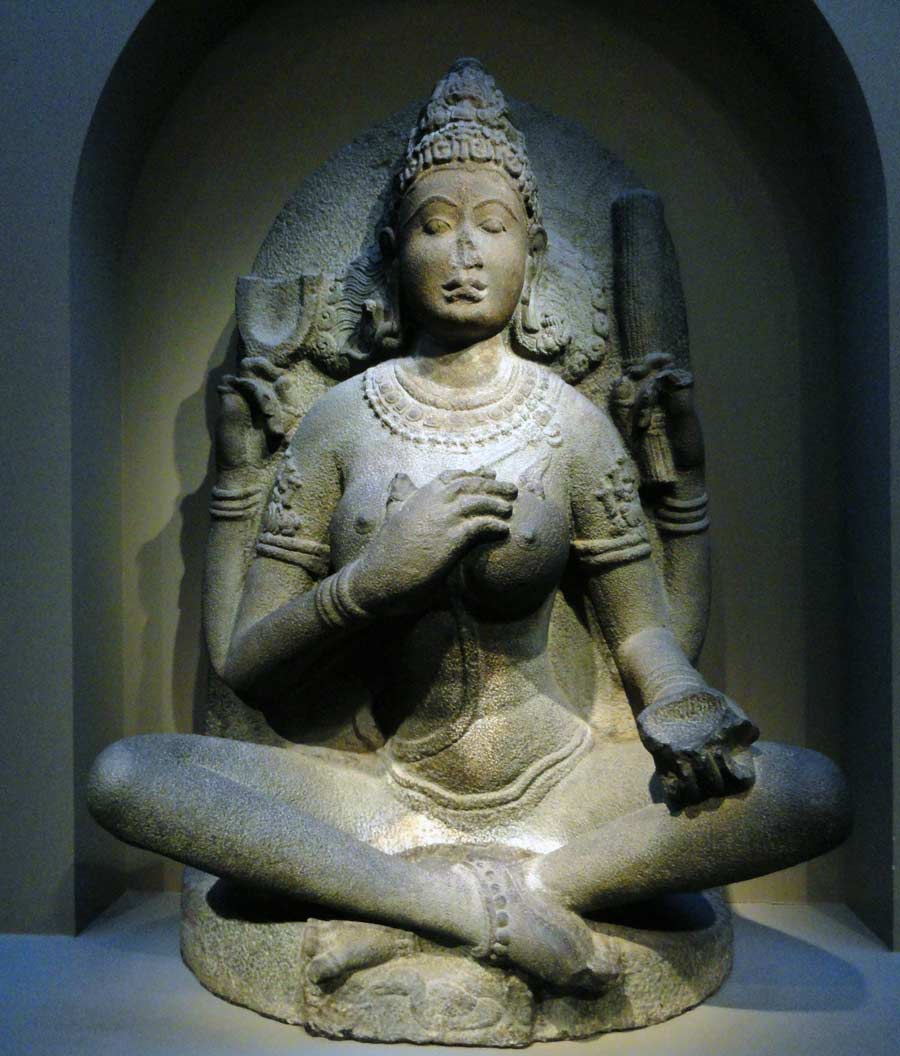
Yogini statue originating from Kaveripakkam, Tamil Nadu in 10th Century - gallery of Arthur Sackler
Editor’s Note: Shantara Khalsa is a Tantrika and Yogini who heard the call of Great Mother while growing up in her native New Zealand, and was called to India on numerous occasions to train and live with several highly developed masters. She has been teaching and practicing for forty-five years and currently divides her time between the Crestone mountains of Colorado, the island of Maui, and New Zealand. She shares her rich insights and a body of wisdom that could only come from walking the warrior's path and tasting the fruits of lifelong practice.
Sutra Journal brings you a chapter from her book Tantra Unveiled every month. She invites questions from readers for ongoing dialogue. Om
Chapter One:
UNDERSTANDING TANTRA
Tantra is a complete spiritual path that culminates in liberation and transcendence of all that limits us as human beings. Tantra is the existence of
manifest creation itself. To be able to hold our personal energy and at the same time to blend totally with another field of consciousness and energy
knowing that all is One, this is tantra. This becomes a dance between the form and formless, and we could not exist without it. Yet seldom is this magic
used in a conscious way. The tantric path is for those people wanting to achieve liberation from the wheel of unconscious death and rebirth in one
lifetime. It is at times a seemingly unspiritual way of approaching the spiritual path, because its very nature defies all that wishes to contract our
existence within unenlightened social consciousness and religious contractions. Tantra is beyond classification and division, i.e., this tantra that
tantra, yet we create a playground of it through classification and division.
It is an advanced yoga within the Indian system and as such is treated with the respect that all spiritual paths deserve. However it is not a beginning
yoga that anyone can start his or her journey on, such as hatha yoga, bhakti yoga, raj yoga, gyan yoga or karma yoga. All beginning yogas create the
clarity and strength of foundation for a person to then leap into tantra if their providence permits this. The various yogic paths have their wisdoms and
suit different people at different times in their evolution.
Most of us can and do start our spiritual path with enquiry into religious scriptures and reading inspirational autobiographies written by practitioners.
The study of religious texts is known as gyan yoga. It is from reading and or listening to teachers of practice lineages that a person begins to believe in
universal laws and the benefits of actively changing their life and consciousness.

Full Moon near Tairua of New Zealand
Beginning yogas have a series of gradual and progressive techniques and understandings that assist us through levels of awakening to who we truly are, how
to be more healthy and happy, and understanding the preciousness and vastness of life. Hatha yoga, for instance, is based on techniques that unite body,
mind and breath and is probably the most widely practiced yoga in the West. Many teachers have brought forth various approaches to this style of yoga, such
as Iyengar yoga, Ashtanga yoga or Kripalu yoga, which are still within the hatha yoga system. Hatha yoga was originally developed as a beginning yoga to
assist people to develop a strong and healthy body. It is not a complete path, rather it is a springboard in which the body is prepared for more advanced
practices. Then a person is able to go further on the spiritual path by means of more advanced techniques, such as Kriya yoga, Kundalini yoga and long
sitting practices where the body and mind must be first healthy, united and at peace.
If you truly want liberation in this lifetime, it is wise to expand through the various yogic paths. By gaining personal experience regarding the depth of
the spiritual process, you can more honestly know how far you want to go in this lifetime. In this way you will better understand if tantra is a viable
path for you.
Tantra, because of its deeply personal and revealing nature, is a subject that is not written about generally from the perspective of direct experience. It
is also true to say that it has remained out of the knowledge of the masses, and that only a few in this culture are truly prepared to embrace tantra (in
its advanced aspects) at this time. Much of the tantric teachings within the Indian, Taoist, and Buddhist systems are taught through word of mouth by
teachers as their students become ready. Non-verbal transmission also becomes more important and viable as a practitioner advances. This is the way many
wisdoms are kept sacred.
Most texts on tantra are written by men, who prefer to write about techniques and principles. Men also keep their personal experiences more secretive than
women and consequently write from a theoretical perspective rather than from direct experience.
Most texts on tantra are written by men, who prefer to write about techniques and principles. Men also keep their personal experiences more secretive than
women and consequently write from a theoretical perspective rather than from direct experience. It is therefore difficult to really understand how to
approach tantra, for it still remains mysterious. As with the majority of spiritual paths there is a priestly undercurrent of control and hierarchy, which
is not to the benefit of women, or men in the long run. For anyone considering the path of tantra finding a qualified and experienced teacher is an
essential ingredient and key to success.
I believe that because tantra is beginning to gain attention within our culture there exists a great need for more qualified teachers, especially females,
to bring tantra into a greater and clearer light. As for myself, I was consumed quickly by the powerfully transformational Love of my tantric master.
Theory never played a part. Principles were something I intuitively developed over many years of experience and only recently, having begun reading some
tantric writings, can I correlate my formed principles and experiences with these writings. It does, however, take many years of experience for the tantric
path to be fully understood. As long as people look for answers through debate and books, tantra will remain a mystery.
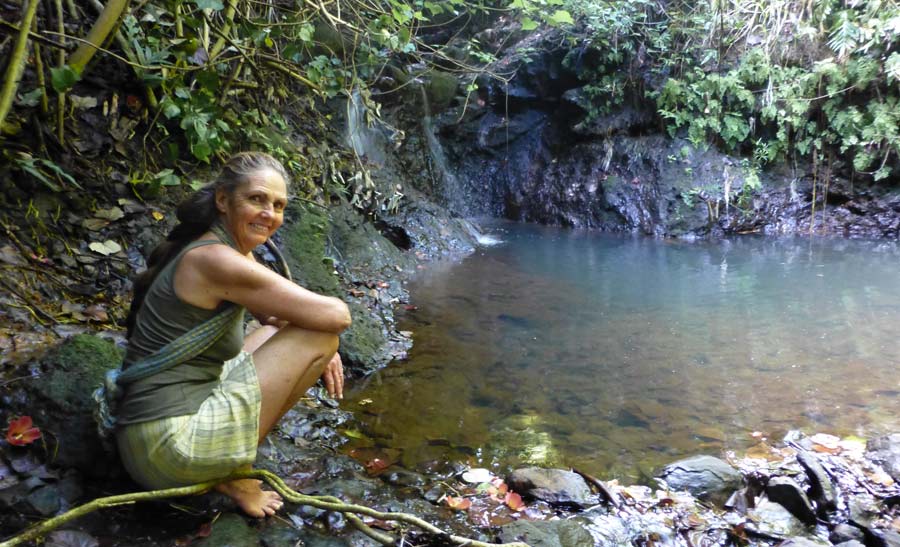
Hidden heart shaped pool in Huelo, Maui
Tantric yoga has definite prerequisites. Preliminary practices need to be mastered first and the practitioner must be free of, or willing to let go of,
continued karmic participation of an obstructive nature. It is also known as the fast and dangerous path because it is easy for a practitioner to become a
monster. It is perhaps because of this very reason that numerous teachers of other forms tend to discount tantra as being a viable path.
One’s approach to tantra cannot be confused, sloppy or random. It requires clarity, pure mindfulness, refinement and an
equal force between self reliance and reliance upon the body of ascended masters.
The Tibetan Buddhists, who have the most available writings on tantra and a mature understanding regarding this path, call tantra the Diamond
(indestructible) vehicle or the Vajrayana path. This comes from their emphasis of the fact that a tantrika (one who practices tantra) is acutely prepared
for this step, understands the need to overcome dualistic thinking and understands the intrinsic perfection of all beingness. Additionally the tantrika is
trained to develop pure vision. This means that the practitioner is able to see from the level of soul beyond the illusion of impermanence or maya. The
Buddhists say and I concur, that one’s approach to tantra cannot be confused, sloppy or random. It requires clarity, pure mindfulness, refinement and an
equal force between self reliance and reliance upon the body of ascended masters or wisdom deities. There is no question in tantra that one
desires to go the full distance and thus resistance to the powerful momentum of this path, as one develops, is evaporated or skillfully transformed.
Tantra, because it is an advanced yoga, differs from most other yogic paths, which are able to accept anyone with any amount of neuroses or karma
(completions). The beginning yogas move people slowly along the spiritual path and do not always require a change in lifestyle. In bhakti yoga, for
instance, the devotee worships an idolized form of god, which may even be their living teacher, but the devotee can never become a god. The devotee is
asked to be pure of heart, compassionate in their actions and read the appropriate scriptures. The devotee is not required to address the deeper issues of
how we become divine and eternal, nor is there emphasis on becoming free of karmic cellular memory, or how one makes a material living without being caught
up in karmic participation. This framework gives freedom to a minimal level and is therefore limited in its outcome.
“Tantra, although recognizing a gradual approach, is in contrast to the normal course of evolution, very speedy. Alternatively, Zen is a very focused
meditative practice, which despite years of practice, prefers to recognize the instantaneous nature of enlightenment or view. This is a way of blending
penetration, transparency and recognition.” One sits upright and does not let the mind wander. One does not explore emotions nor indulges in
inner visions, but one does learn to connect to their breath and body. This discipline builds strength of character in certain ways. Yet, because of its
lack of integration with the emotions and passion, and its somewhat hit or miss approach to enlightenment, many of its practitioners will become contracted
and will drown in limitation.
Zen is one of a number of valuable paths of meditative unfoldment, quite advanced in its potential, yet because of the lack of emphasis with integrating
emotion and passion as an aspect of enlightened activity, this eventually results in many of its practitioners becoming stuck rather than continuing
forwards.
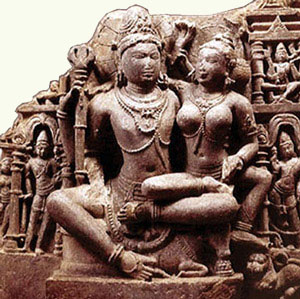 This is not the case of tantra that says you must be ready to do it all; no rock is left unturned, and nothing is unacceptable in our personal practice as
long as it serves the individuals spiritual progress. If, however, we loose our balance and purity, a monster may be the result. By remaining in close
physical proximity to one’s teacher, this will be checked, but when one is on their own, or declares oneself a law unto oneself, this powerful momentum and
total freedom of personal power often corrupts.
This is not the case of tantra that says you must be ready to do it all; no rock is left unturned, and nothing is unacceptable in our personal practice as
long as it serves the individuals spiritual progress. If, however, we loose our balance and purity, a monster may be the result. By remaining in close
physical proximity to one’s teacher, this will be checked, but when one is on their own, or declares oneself a law unto oneself, this powerful momentum and
total freedom of personal power often corrupts.
Tantra, therefore can only be entered into by a mature practitioner who is secure in their own inner awareness, and who has burnt off gross karmas,
including all the neurotic emotions that support the illusion of separate existence. To have achieved this level of realization one is established in the
emptiness and able to hold a non-dualistic view of creation.
A person with a dualistic mind prays to something separate to and outside of their self for help and views the world from a “them and us” perspective. In
non-dualism we are empowered by being self-responsible, a co-creator in this universe, and thus able to flow with life’s circumstances, and no matter how
difficult things may appear, we know them to be of the perfection and they are always workable and accepted as opportunities, even blessings.
In a dualistic mind with its limitations there is always rigidity. Life is great as long as it is going a certain way, but struggle arises frequently as
the impermanence of nature arises, and change becomes an obstacle rather than an opportunity. In duality the mind can never truly be at peace in the
emptiness, for its very nature is grasping and often obsessed by the ego’s petty agendas, even be it building a million-dollar empire. When the empire
collapses its builder is devastated because something went wrong.
In non-dualism the mind is free to explore the vast emptiness and one no longer clings to people and things of an impermanent nature. We know ourselves as
one with the power of creation, and we have the inner strength and wisdom that no longer looks at the source of our problems, or salvation, as an external
force.
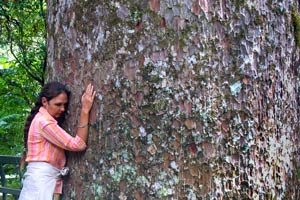 To enter into Tantra, a tantrika must have experienced the oneness and be comfortable in the emptiness. “This is first experienced by going deep into our
core, where there is only the radiance of subtle mind. This is enlightenment and from here we gradually loosen our mind so as to perceive everything in
this transparent way. Nothing exists as a solid object; rather it is all radiance that spontaneously and eternally emanates out of this indescribable,
ever-present, blissful nothingness. The effort of being has disappeared. Emptiness and Oneness are interchangeable terms in the enlightened view.”
To enter into Tantra, a tantrika must have experienced the oneness and be comfortable in the emptiness. “This is first experienced by going deep into our
core, where there is only the radiance of subtle mind. This is enlightenment and from here we gradually loosen our mind so as to perceive everything in
this transparent way. Nothing exists as a solid object; rather it is all radiance that spontaneously and eternally emanates out of this indescribable,
ever-present, blissful nothingness. The effort of being has disappeared. Emptiness and Oneness are interchangeable terms in the enlightened view.”
Here there is no ground to stand upon that guarantees security, because tantra is not held together by mental concepts, of which the word “secure” is one.
In the emptiness there is no goal and this wisdom is sustained through manifested creation. The mind, as it is normally referred to, is transcended, yet
there is still perception and communication through the light which is not void - rather it exists of radiant alive consciousness. One moves upon the vast
ocean of permanent impermanence.
This continuity of consciousness is tantra.
Tantra in Sanskrit means continuum and the fuel for this path is bliss.
The bliss is tantric awareness, which requires pure vision or overcoming illusory ordinary appearances. Ordinarily we see only what we believe to be true.
At a young age many beliefs of our parents and adults at large are passed onto us whether we ask for them or not. A comprehensive mental framework is
already established by the young age of seven years, and thereafter it is no longer usual for young children to remain innocently in their own world and
form ideas in their own timing. Our personal karmas also veil pure vision. Thus we are conditioned in our thinking and seeing from the beginning. This
conditioned seeing is often held to maintain the structure of our society and minimize disruptions in daily life, such as parents not wanting to be
bothered with or not feeling able to deal their children’s pain. Whilst it appears essential that children fit into the perimeters of our society, this
molding of us does not allow full freedom of individual evolvement.
Multi-dimensional awareness and seeing in sensitive and refined souls is shut down at a young age. Telepathy and clairvoyance is not yet accepted as normal
and encouraged to be developed and enhanced, as the majority of human beings have not maintained this spiritually advanced, inner visionary guidance and
understandings. We too often pass these things off as not that relevant to everyday physical existence, because soul awareness is shut off.
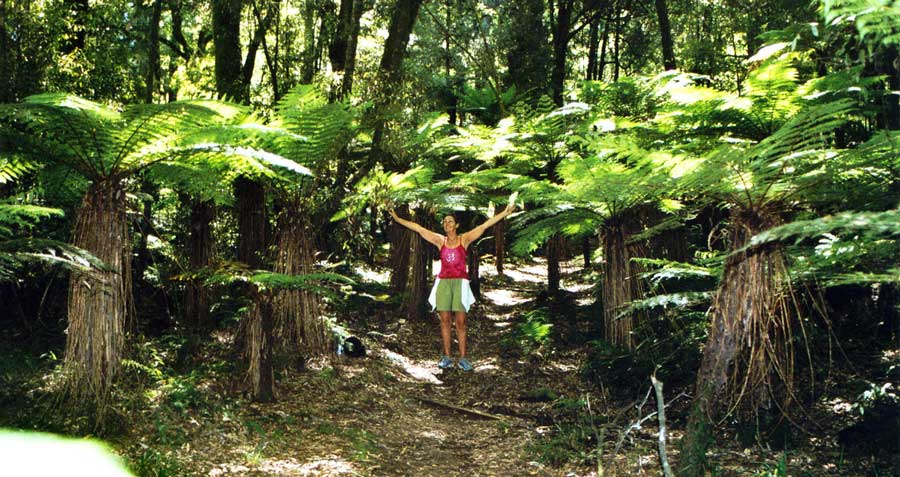
Whirinaki Forest of New Zealand
Quietness of mind and spirit is replaced by constant activity and thus humans have become disconnected from whence they came. The soul disconnects from
everyday clutter and the belief in separate existence occurs. How many of us have remained connected to the non-verbal voice of the wind, sun, stars,
animals, trees, and other life forms? As we shrink in the expansiveness of our consciousness so does the purity of our vision.
This is why we must embrace a spiritual path filled with skillful means and understandings to once more regain pure vision to become enlightened and
liberated from the illusion of separation and death. With pure vision we are once again able to see multi-dimensionally and function from our soul. Our
soul energy is also known as our “I AM Presence” from the ascended master tradition, or our Sambhogakaya body from the Buddhist tradition. When we have
regained pure vision we are able to see the beloved ascended masters, who are called the wisdom deities in Tibetan Buddhism. We are also able to see the
cause of karma and samsara. The light behind pure vision is called “ati.” Ati is the light of creation, which is seen and known only by our buddhic nature,
not by our ordinary mind or vision. Ati is the clear light beyond form, perceived from formlessness; our formlessness is where we reside as Oneness.
Ati is the light of pure vision from where we overcome ordinary appearances, and tantra is the dance of the enlightened being who is awake in these realms.
To make the quantum leap from ordinary vision to pure vision, from separation to oneness, one must do certain purification practices and receive the
transmission of a teacher. One can no longer chart the spiritual path alone as one can in the preliminary yogas. Transmission is the passing of enlightened
energy from one being to another, and there must be the openness to receive. Without the deep surrender (letting go) of the ordinary dualistic mind there
cannot be receptivity. A student is defined as the one who is receptive and the teacher is the one who holds the enlightened experience. When the student
is prepared transmission occurs in a number of ways, and much of this is grace. As the dance of purifying and transmission continues, so does pure vision
become stronger. As the tantrika progresses, the transmissions occur more frequently from the inner and only with this pure vision can one receive
transmission from the beloved ascended masters, or wisdom deities.
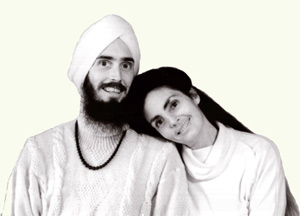 Virochana (my twin ray) and I have received countless transmissions from the ascended masters since coming together in 1987. One of the many things that
these transmissions have taught us is that the tantric path can be navigated by a twin ray couple, provided they have passed through the preliminary stages
and are committed to further practice. If twin ray energy can stay together they are each other’s greatest teachers. Over the past eleven years we have
been shown approximately a dozen twin ray couples, yet only one of these couples are able to stay together at this time. The intensity of this relationship
requires each person to be strongly active on the spiritual path and to clear many karmic patterns.
Virochana (my twin ray) and I have received countless transmissions from the ascended masters since coming together in 1987. One of the many things that
these transmissions have taught us is that the tantric path can be navigated by a twin ray couple, provided they have passed through the preliminary stages
and are committed to further practice. If twin ray energy can stay together they are each other’s greatest teachers. Over the past eleven years we have
been shown approximately a dozen twin ray couples, yet only one of these couples are able to stay together at this time. The intensity of this relationship
requires each person to be strongly active on the spiritual path and to clear many karmic patterns.
Our personal experiences as a twin ray couple has brought a new light into understanding the workings of tantra and the infinite oneness. Tantra as a path
cannot be contained within the definition of one particular approach. It is beyond the control of man-made dharmas (religions) and hierarchies. Tantra
eludes contraction and needs no outer form to secure its existence in creation, as it is truly the path of mystics and warriors. Tantra has been held in
the realms of secret teachings for thousands of years and it is not always given the name tantra. For eons tantra has existed and been held as an inner
teaching by the ascended masters (wisdom deities) who continue to keep the path dynamic as humanity evolves.
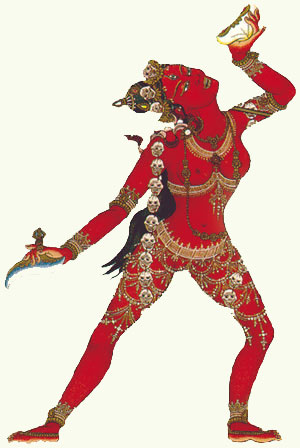 The tantric lineage is our lineage and the ascended masters our eternal teachers and family. Due to past life yogic practices, I was from childhood blessed
with strong inner protection and guidance. It was therefore natural and ordained that my first master be an accomplished Tantrika, and that surrender was
never an issue for me.
The tantric lineage is our lineage and the ascended masters our eternal teachers and family. Due to past life yogic practices, I was from childhood blessed
with strong inner protection and guidance. It was therefore natural and ordained that my first master be an accomplished Tantrika, and that surrender was
never an issue for me.
As one becomes established in tantra, transmission becomes more and more the normal, through conscious communion with the wisdom deities. The tantrika
overcomes separative existence and merges into the body of the One. The One is our eternal pure being. All else is known as the passing show.
The lady Ascended Master VajraYogini also known as Mu gave me these words. “Only those people who are free of karmic participation are able to practice
tantra.”
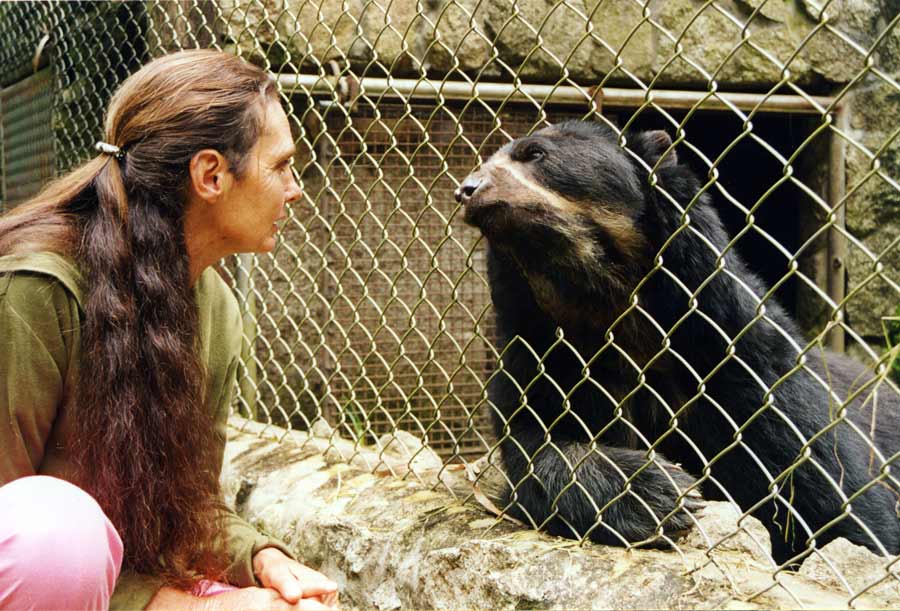
Talking with a Bear in Aqua Caliente - Peru